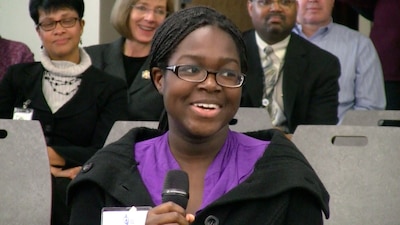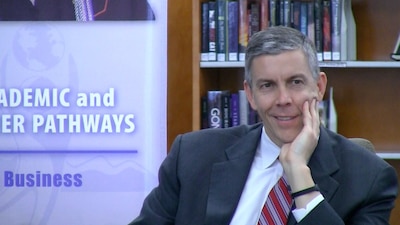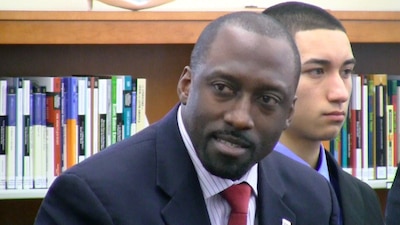AURORA – In Janet Mensah, a high school senior with her foot in the door at the University of Colorado School of Medicine, U.S. Education Secretary Arne Duncan sees the American dream.

Mensah always knew she wanted to be a doctor, she told Duncan during a roundtable discussion Tuesday at the Vista PEAK P-20 campus, she just didn’t know how to get make it happen.
“My mom never went to school and my dad, I guess, stopped school in the eighth grade so I didn’t really have that background, I didn’t know what to do,” she said. “I knew my dream, but how do I get there?”
At Smith, an assistant principal told her about Aurora LIGHTS, one of the district’s “pathways” programs that strives to prepare students starting as early as elementary school for careers in health sciences, business, math and engineering, or arts and communications.
Dr. Allegra Melillo, a family doctor and assistant professor at the CU School of Medicine, said Mensah took advantage of every opportunity through her chosen pathway – from research internships on the medical campus to summer institutes to engaging in “very hard curriculum that … we decided was important and critical.”
Mensah has been accepted into CU-Denver’s BA/BS – MD program, meaning she’ll be enrolling in both the CU undergraduate program and its medical school.
“A young woman who doesn’t have a parent who graduated from eighth grade, not even high school, and here she is, she’s going to be a doctor,” Duncan told reporters later. “That’s the American Dream, that’s what this is about.
“I’m just really inspired by this.”
Pathways responds to ‘Colorado Paradox’
Aurora Public Schools Superintendent John Barry begins conversations about pathways with what’s popularly known as the Colorado Paradox:

The state has one of the nation’s most highly educated adult workforces yet it ranks near the bottom in the percentage of high school graduates who go on to college. In other words, Colorado is importing many of its highly-skilled workers.
So Barry, who is no stranger to complex problems – he helped lead the investigation into the space shuttle Columbia accident before taking over in Aurora in 2006 – began talking to professionals throughout the city.
That gave birth to the Community Workforce Planning Team, an alliance of 30 public and private companies and organizations that created a five-year plan to better align what’s taught in public schools with what’s needed for success in the workforce and in college. Pathways are the main ingredient.
“We are trying to do something … unique to the nation,” Barry told Duncan on Tuesday.
Six Aurora elementary schools, eight middle schools and four district high schools offer at least one pathway. The goal is that every school will offer one or more pathways by 2015.
Students can choose to enter into a pathway or not, and they can switch pathways if they want — though that may involve switching schools.
At Montview, one of the six elementary schools offering pathways, Principal Michelle Barone said her job is getting students to think about possible careers early and then preparing them for their choices.
She said her school is “math-focused,” noting “All pathways require a strong math background so our teachers spent a lot of time developing conceptual understanding.”
How pathways work K-12
Montview feeds into North Middle School, located across the street from the Anschutz Medical Campus, site of the CU School of Medicine.
North Principal Gerardo de la Garza said about 180 of the school’s 742 students participate in its Academy of Health Sciences and Technology, part of the health sciences pathway.
“They’re definitely more motivated to come to school because they have all these experiences at the Anschutz Medical Campus,” he said.
In high school, pathways students can begin taking college classes in their fields and earning industry certificates, such as Microsoft Office Specialists certificates in Word, PowerPoint and Excel.
Alex Santana, a business pathways student at Vista PEAK, said those courses are helping him understand the business side of his dream – becoming a pastry chef and owning his own bakery: “It helps me get that much closer to my goal.”
Barry said teachers were challenged to contribute to the pathways and one who responded was Justin Hoffman, a high school teacher at Vista PEAK.
“We decided we wanted to create something entirely new,” said Hoffman, who teaches physical education. “We settled on the idea of creating a certified personal training program.”
The new Human Performance Institute will be part of the health sciences pathway and will launch this fall with 30 freshman. After four years, students will be able to test to earn a national personal training certificate.
“If a student wants to work during college as a personal trainer, a fitness instructor, they can actually fund their college through those things,” Hoffman said.
Beyond K-12, college and workforce
Aurora’s focus on P-20 – or preschool through college – pathways was aided by the 2010 state ASCENT law, the “fifth-year” concurrent enrollment program which pays for students to simultaneously earn a high school diploma and a two-year associate’s degree.

Linda Bowman, president of Community College of Aurora, told Duncan that her school has the highest concurrent enrollment in the state and, this year, will award more than 6,000 college credits to Aurora students.
“Our organizations are absolutely intertwined,” she said of the community college and the school district. “We even share personnel, we share payroll so that we can focus on the fact that we all have the same purpose … Three of Aurora’s high schools – and soon to be more – are actually sites of the community college.”
That makes it easier, for example, for Hoffman to create a personal training program that can flow right into an associate’s degree, and then into a four-year degree if desired.
Bill Petry, a science teacher at Rangeview High School, said the business partnerships have helped educators understand what their students need to know.
“We’ve been able to talk with a company like Northrop Grumman and find out from engineers what’s required from an engineer,” he told Duncan. “We’ve learned new terms like technical arrogance and the importance of being able to present your ideas effectively and the importance of project management.”
All of that will help the president’s ambitious goal of producing one million engineers by 2018, Petry said.
Duncan asked a series of questions, prodding for advice.
“If you were in my shoes, what would you like to see us doing different or better?” he asked Marcos Stephens, senior training manager at Northrop Grumman Corp.
Stephens urged Duncan to “make engineering cool again” – and to focus on improving math instruction across K-12.
“I admit when I was in high school, I was afraid of math,” Stephens said. “Because I really didn’t get the fundamentals that I needed early on, in middle school and in elementary school.”
